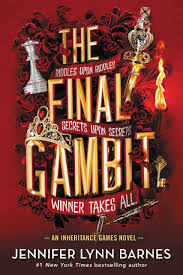
The Final Gambit (The Inheritance Games)
CHAPTER 57
by Barnes, Jennifer LynnJameson leads the protagonist to a hidden gemstone room concealed behind a model train setup on the third floor. The room, lined with obsidian and agate crystal slabs, serves as a dramatic setting for a pivotal confrontation. When the protagonist steps inside, Jameson traps them there, revealing his plan to leave without them. Through a phone call, Jameson explains his intentions, hinting at a dangerous mission involving Grayson and Eve, while the protagonist demands to be released, frustrated and concerned for his safety.
The conversation shifts as Jameson reveals the origin of his scar, a deeply personal story about revisiting the cliff where Emily died. He describes his reckless jumps and the near-fatal injury caused by a submerged tree branch, framing it as a metaphor for Grayson’s current emotional turmoil. Jameson emphasizes that Grayson, usually the steadfast one, is now unmoored, and he feels compelled to step up as the strong one. This confession underscores Jameson’s protective instincts and his determination to shield both Grayson and the protagonist from further harm.
The protagonist pleads to join Jameson, arguing they don’t need protection and insisting on being part of the mission. Jameson, however, remains resolute, stating that the Hawthorne family’s mess is their responsibility to clean up. He admits he doesn’t trust Eve, aligning with their grandfather’s warning, but reassures the protagonist that they are the only person he truly trusts. This moment highlights the tension between Jameson’s loyalty to his family and his deep connection to the protagonist.
The chapter ends abruptly as Jameson hangs up, leaving the protagonist trapped in the gemstone room. The unresolved tension and Jameson’s cryptic final words—“the only person I trust with all that I am and all that could be, Heiress, is you”—leave the protagonist and readers questioning what dangers lie ahead. The chapter masterfully blends emotional vulnerability with suspense, setting the stage for the next phase of the story.
FAQs
1. What is the significance of the hidden gemstone room in this chapter, and how does it function in the plot?
Answer:
The hidden gemstone room (lined with obsidian and agate crystal) serves as both a physical trap and a symbolic representation of Jameson’s protective instincts. Functionally, it allows Jameson to confine Avery against her will to prevent her from joining him and Grayson on their dangerous mission to find Eve. Symbolically, the precious stones reflect the value Jameson places on Avery’s safety, even as he makes questionable decisions to protect her. The room’s sudden enclosure mirrors how Avery is being forcibly shut out from the Hawthorne family’s dangerous affairs, despite her protests.2. Analyze Jameson’s revelation about his scar. How does this backstory deepen our understanding of his character and current motivations?
Answer:
Jameson’s confession about intentionally recreating Emily’s fatal cliff jump reveals his self-destructive tendencies and complex grief. By risking the same danger that killed his ex-girlfriend, he demonstrates a pattern of processing pain through physical recklessness—a trait that now manifests in his willingness to face danger for Grayson. This history explains why he feels compelled to protect Avery by leaving her behind (“let me be the one who protects you”) and shows his growth in recognizing Grayson’s unstable state (“he’s lost his mooring”). The scar story transforms Jameson from a thrill-seeker to a deeply loyal but traumatized character.3. How does the dynamic between Avery and Jameson evolve in this chapter, particularly through their phone conversation?
Answer:
Their relationship reaches a turning point through raw vulnerability. Jameson breaks his usual playful demeanor (“no innuendo”) by using Avery’s real name and admitting she’s the only person he trusts—a stark contrast to his earlier evasiveness. Avery shifts from frustration to genuine concern, recognizing his protective intent but rejecting his methods (“I don’t need you to protect me”). The phone call’s abrupt end underscores Jameson’s unilateral decision-making, straining their partnership. This interaction lays groundwork for future conflict, as Avery is clearly unwilling to be sidelined in family crises.4. Evaluate the chapter’s exploration of trust. How do different characters demonstrate or violate trust, and what warnings are implied?
Answer:
Trust is central: Jameson trusts only Avery while doubting Eve (“I don’t trust Eve”), Grayson trusts Jameson enough to collaborate post-On Spake, and Avery’s trust in Jameson is tested by his deception. The late Hawthorne’s warning (“Don’t trust anyone”) looms over these dynamics, especially regarding Eve’s unclear motives. Jameson’s unilateral action—trapping Avery—ironically violates trust while claiming to protect it. The chapter suggests trust must be actively negotiated (Avery’s protests) rather than assumed, foreshadowing that Grayson’s blind pursuit of Eve may have consequences.
Quotes
1. “Jameson Winchester Hawthorne lived for danger.”
This quote perfectly encapsulates Jameson’s character and his reckless, thrill-seeking nature. It comes at a pivotal moment when Avery realizes he’s about to embark on a dangerous mission, highlighting his tendency to embrace risk.
2. “I went back to the place where Emily died—I went back.”
This haunting confession reveals Jameson’s traumatic past and his self-destructive tendencies. The quote shows his grief over Emily’s death and how he tried to process it by recreating her fatal jump, marking a key moment of vulnerability.
3. “Gray is going to keep jumping until it hurts… And now, he’s lost his mooring, and I have to be the strong one.”
This insightful quote demonstrates the role reversal between Jameson and Grayson, showing Jameson’s growth and his determination to protect his brother. It reveals the depth of their relationship and the chapter’s theme of family responsibility.
4. “The only person I trust with all that I am and all that could be, Heiress, is you.”
This powerful declaration represents the emotional climax of the chapter, showing Jameson’s deep trust in Avery. It contrasts with his distrust of Eve and underscores the central relationship in the story while revealing his vulnerable side.
